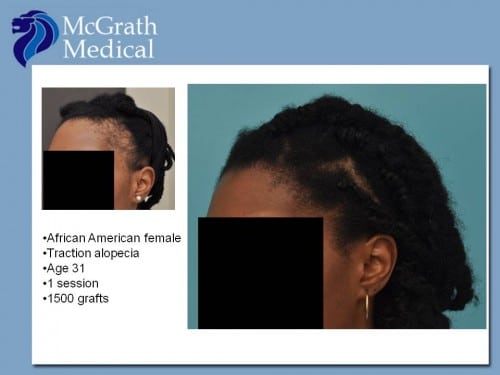Treating Traction Alopecia: Your Hair Needs a Break, Too
 Alopecia, a skin disorder that causes hair to fall out, is the most common cause of hair loss in women. While there are several types of alopecia, traction alopecia is the most prevalent in African American women, who make up nearly 40 percent of the estimated 80 million people in the U.S. who suffer from alopecia at some time in their lives. Traction alopecia is hair loss caused by the constant pulling or tension on the hair follicles, common with braiding, tightly coiled twists, extensions, weaves and other tight hair styles.
Alopecia, a skin disorder that causes hair to fall out, is the most common cause of hair loss in women. While there are several types of alopecia, traction alopecia is the most prevalent in African American women, who make up nearly 40 percent of the estimated 80 million people in the U.S. who suffer from alopecia at some time in their lives. Traction alopecia is hair loss caused by the constant pulling or tension on the hair follicles, common with braiding, tightly coiled twists, extensions, weaves and other tight hair styles.
The continuous pull on the hair can cause hair loss at the frontal hairline, posterior hairline, temples and above the ears. Traction alopecia can also occur due to over-processing. Chemical treatments such as dyes, bleaches, or straighteners disrupts the keratin structure in a manner that reduces its tensile strength. The hair can become fragile and heavy fall-out can occur with simple brushing or combing.
If diagnosed early enough, traction alopecia can be reversed and the hair will grow back. If left untreated with continued strain on the hair follicles or continued abundance of chemicals, the hair loss may not be so easily reversed without a hair transplant procedure.
Unfortunately, traction alopecia can also be accelerated by the methods that are intended to cover or camouflage the hair loss, such as hair weaves and extensions. These “solutions” actually cause constant tension on the hair follicles, which is the cause of the hair loss in the first place.
As with the rest of your body, your hair needs a break, too. In order to avoid or stop hair loss from occurring due to traction alopecia, hair styles that put strain on the hair should be changed for a looser, gentler hair style. Chemical processing should be few and far between, giving hair a chance to recover.
If hair loss as a result of traction alopecia is permanent, there are a few hair transplantation options. A follicular unit extraction (FUE) hair transplant is often the best option for African American women because it does not leave a visible scar and individual hair follicles can easily be placed in the specific areas affected.
While many forms of hair loss are not as easily reversed, traction alopecia is one form that can be reversed if caught in time.
